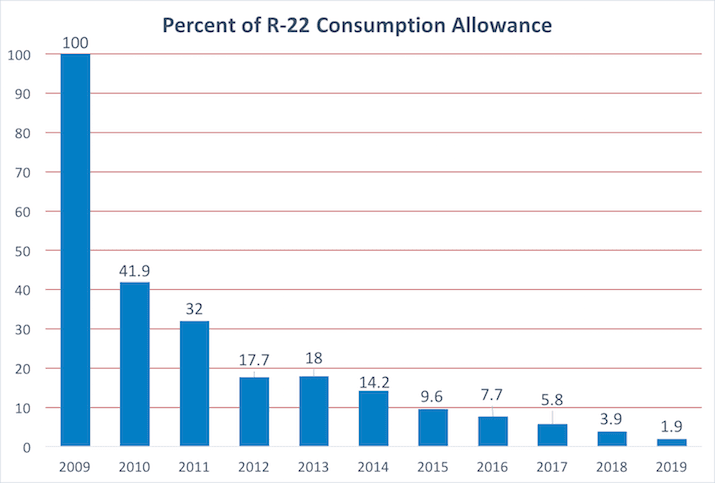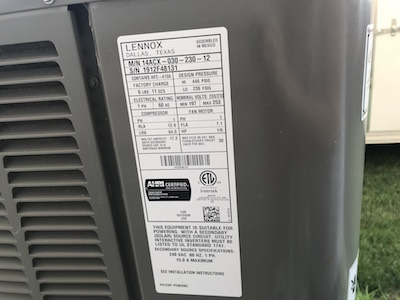What Will Happen to R22 and How it Affects You
If your air conditioner was installed before 2010 and you don’t know what R22 is then you should probably find out more. R22 refrigerant is a chemical that keeps the air coming from your air conditioning system cool, so it’s certainly incredibly critical. Most air conditioning units older than 10 years use an AC refrigerant called R22 that’s commonly identified as Freon*, and is referred to by the EPA as HCFC-22. In this article, we’ll use the name R22. This refrigerant was introduced in the 1950s and became the main AC refrigerant in the residential heating and cooling industry.
The Montreal Protocol
Fast forward a few decades and the world realized that R22 refrigerant was aiding in the depletion of the Earth’s ozone layer. Not cool. So, the U.S. EPA, in cooperation with other agencies and groups around the world, initiated a phase out of many ozone-depleting agents as part of an international agreement known as the Montreal Protocol. The regulation lists many HCFCs and CFCs (different types of refrigerants that deplete the ozone layer), but R22 is recognized as one of the worst offenders.
Timeline and R22 phase out progress in 2018
In 2003, the phase out of R22 production and imports commenced. By early 2010 the production and import of R22 was reduced. However, servicing current, existing equipment is still allowed if there is an available supply of R22. To ensure the public’s compliance with the new law, all sales of R22 must be acquired by a certified technician R22 refrigerant will be available to service existing air conditioners after 2020.

So how does this affect prices?
If you are starting to think this is a great topic for an economics professor regarding supply and demand, then you are right. As you likely understand, older air conditioners more often have leaks and need repairs. Any air conditioners that are older than 2010 are more likely to use R22, which means there’s a lot more demand for it, and a reduced supply. Prices have only increased due to scarcity.
Don’t forget that in order to obtain R22, you’ll need to be an EPA-certified technician. So, the average homeowner isn’t able to purchase a cylinder themselves. Also, there are some firm regulations now on how refrigerant must be reclaimed and recycled, which increases expenses. This fee is passed on to the homeowner as companies are forced to cover the increased overhead connected to R22 repairs. There are requirements for importing, labeling, record keeping, reporting, destruction and reclaiming of R22 from existing air conditioners.
So, how does this impact you?
The cost of R22 is dramatically increasing because of the dwindling supply, and new refrigerant will no longer be available for use at all after 2020, with the exception of recycled quantities.
If you’re thinking, “Man, this is starting to sound expensive,” you’re spot-on, it is. This is why when our experts come out to review your unit we look to see what refrigerant your unit uses, and in many cases, we’ll recommend an upgrade because of the increasing cost of sustaining an R22 air conditioner.
How do I know if my unit uses R22?
If your home has an air conditioning system that was built before 2010, your AC will typically have R22. However, if you installed your air conditioner after January 1, 2010, then your system may not have R22. You can see the type of refrigerant your system runs on by reading the appliance’s nameplate. This nameplate is typically found on the outdoor condenser of your central air conditioning system. If you don’t find it, you can grab your user’s manual. Otherwise, you can reach out to your local Service Experts center. If you have a maintenance agreement with us, we also have your information on hand and a tech can let you know right away if your unit uses R22.
Instead of Freon, use Puron
The industry has moved from R22 to R410a, which you may identify by the brand name Puron. Throughout this article, we’ll use the name R410a (although Puron is a well-known brand, there are other companies that make R410a). There are some key benefits to switching from an R22 air conditioning unit to one that uses R410a. It provides a higher safety rating tests than R22.

You may have read about “drop-in” replacements for R22. We strongly against against this option. Typically a homeowner who is uneasy about the cost of replacing their system seeks out an alternative, and this sounds like an easy solution. It usually costs the homeowner more money, and nearly always voids the manufacturer warranty. The fact about “drop-ins” is that there is no “drop-in” solution where you simply swap out the refrigerant. The phrase “drop-in” is suggesting retrofitting a unit, which when done properly can cost the homeowner as much, or more, money than purchasing a new unit that uses R410a. In part, this is because different refrigerants operate at different pressure levels and need different parts to run, which results in the technician needing to replace the most expensive components of your system to be compatible with the new refrigerant. If this vital step is missed, your system will quickly stop operating, and you’ll end up installing a new unit anyway. If you insist on exploring retrofitting, then consult with an HVAC company to determine your best option.
Your manufacturer will probably not pay for the parts to make this swap because retrofitting your AC system will likely void the warranty. It’s typically just a temporary fix, but shopping for a new upgraded AC system will probably benefit most homeowners in dependability, satisfaction, and long-term comfort.
It’s wise to discuss pricing options with your HVAC provider if you’re concerned about cost. At Service Experts Heating & Air Conditioning, we offer financing that makes a replacement affordable, and we keep track of any manufacturer and utility rebates that would make it easier to swallow a surprising replacement. To avoid emergencies on a hot day, lots of our customers decide to do a pre-emptive replacement, and replace an old system before it doesn’t work. If you’re considering that route as well, then you’re in good company!
If your unit was built after 2010, you’re probably safe
If your heating and air conditioning system was built after January 2010, the R22 phase out challenge may not apply to you, because it’s possible that your system uses the new, approved replacement refrigerant, R410a. However, air conditioners installed after 2010 could still use R22, so it’s wise to check with an HVAC Expert. You can always find this and the refrigerant type by reviewing the nameplate on your condenser (the condenser is the outside unit).

What do I do if my air conditioner uses R22?
To review, if your HVAC equipment was produced prior to January 2010, particularly if it’s older than a decade, you have a few options:
- Shop for an upgraded, more environmentally-friendly system that uses R410a.
- Reach out to an expert to replace the parts in your current unit to help make it compatible with an approved air conditioner refrigerant. This is not advised.
- Stick with using recycled R22 and burn through costs like it’s the ozone layer.
To be clear, the EPA regulates the production and use of this refrigerant, but not your unit. You are not required by the law to replace your air conditioner. Ultimately, your AC will stop working and it will need to be replaced, and only R410a units will be available to buy.
The ideal option is to buy a new, upgraded air conditioner, especially if your current air conditioner is already more than 10 years old. Service Experts Heating & Air Conditioning has several financing options that help to meet your budget, and again, we look out for rebates from HVAC manufacturers and local utilities to make it easier on you. New AC equipment is more efficient and offer you superior comfort, helping to reduce your energy costs.
You could also select the status quo and continue using recycled R22 air conditioning refrigerant for the near future. While this sounds like a good alternative, the price of servicing old R22 A/C systems is starting to exceed several hundred dollars (easily a down payment on a new system). You may also see the prices climb as demand continues to rise on a substance that is no longer produced or widely accessable.
If you aren’t confident what type of AC refrigerant your air conditioning system uses, we can help. Reach out to Winnipeg Supply Service Experts today and we can provide an inspection to confirm if you are currently using R22 and, if so, what you can do.
The good news
While making the transition to an approved AC refrigerant may stressful, it’s helping to save the ozone layer. These regulations will help protect the ozone layer in the Earth’s atmosphere, which helps block radiation from the sun and prevents serious illnesses, such as skin cancer. It’s not exaggerated to say that you, as a homeowner, are a large part of this by replacing an old R22 unit with a newer, ozone friendly unit.
If you have any questions, please use us for a free, in-home consultation by filling out the form below.
*Freon is a registered trademark of the DuPont Corporation
Sources:
1.https://www.federalregister.gov/documents/2013/12/24/2013-29817/protection-of-stratospheric-ozone-adjustments-to-the-allowance-system-for-controlling-hcfc

